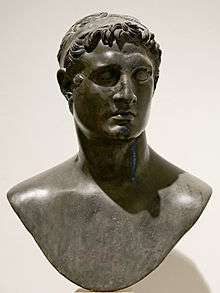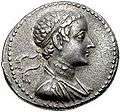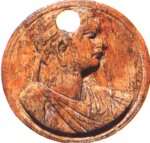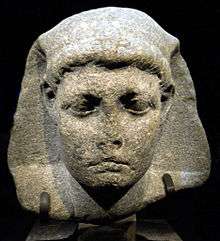Ptolemaic dynasty
| Ptolemaic Dynasty | ||||||||||||||
|---|---|---|---|---|---|---|---|---|---|---|---|---|---|---|
| ||||||||||||||
| Country | Ancient Egypt, Macedonia, Mauretania | |||||||||||||
| Titles | Pharaoh, King of Macedonia, King of Mauretania | |||||||||||||
| Founded | 305 BC | |||||||||||||
| Founder | Ptolemy I Soter | |||||||||||||
| Final ruler | Cleopatra VIII | |||||||||||||
| Current head | extinct | |||||||||||||
| Ethnicity | Greek | |||||||||||||
The Ptolemaic dynasty /ˌtɒləˈmeɪ.ᵻk/ (Ancient Greek: Πτολεμαῖοι, Ptolemaioi), sometimes also known as the Lagids /ˈlædʒᵻdz/ or Lagidae /ˈlædʒᵻˌdiː/ (Ancient Greek: Λαγίδαι, Lagidai, after Lagus, Ptolemy I's father), was a Greek[1][2][3][4][5] royal family, originating from Macedon, which ruled the Ptolemaic Kingdom in Egypt during the Hellenistic period. Their rule lasted for 275 years, from 305 to 30 BC. They were the last dynasty of ancient Egypt.
Ptolemy, one of the seven somatophylakes (bodyguards) who served as Alexander the Great's generals and deputies, was appointed satrap of Egypt after Alexander's death in 323 BC. In 305 BC, he declared himself Ptolemy I, later known as Sōter "Saviour".
The Egyptians soon accepted the Ptolemies as the successors to the pharaohs of independent Egypt. Ptolemy's family ruled Egypt until the Roman conquest of 30 BC.
All the male rulers of the dynasty took the name Ptolemy. Ptolemaic queens regnant, some of whom were the sisters of their husbands, were usually called Cleopatra, Arsinoe or Berenice. The most famous member of the line was the last queen, Cleopatra VII, known for her role in the Roman political battles between Julius Caesar and Pompey, and later between Octavian and Mark Antony. Her apparent suicide at the conquest by Rome marked the end of Ptolemaic rule in Egypt.
Ptolemaic rulers and consorts
Dates in brackets represent the regnal dates of the Ptolemaic pharaohs. They frequently ruled jointly with their wives, who were often also their sisters. Several queens exercised regal authority. Of these, one of the last and most famous was Cleopatra ("Cleopatra VII Philopator", 51–30 BC), with her two brothers and her son serving as successive nominal co-rulers. Several systems exist for numbering the later rulers; the one used here is the one most widely used by modern scholars.
- Ptolemy I Soter (303–282 BC) [6] married first Thaïs, then Artakama, then Eurydice, and finally Berenice I
- Ptolemy II Philadelphus (285–246 BC) married Arsinoe I, then Arsinoe II; ruled jointly with Ptolemy Epigonos (267–259 BC)
- Ptolemy III Euergetes (246–221 BC) married Berenice II
- Ptolemy IV Philopator (221–203 BC) married Arsinoe III
- Ptolemy V Epiphanes (203–181 BC) married Cleopatra I Syra
- Ptolemy VI Philometor (181–164 BC, 163–145 BC) married Cleopatra II, briefly ruled jointly with Ptolemy Eupator in 152 BC
- Ptolemy VII Neos Philopator (never reigned)
- Ptolemy VIII Physcon (170–163 BC, 145–116 BC) married Cleopatra II, then Cleopatra III; temporarily expelled from Alexandria by Cleopatra II from 131-127 BC, then reconciled with her in 124 BC.
- Cleopatra II Philometora Soteira (131–127 BC), in opposition to Ptolemy VIII Physcon
- Cleopatra III Philometor Soteira Dikaiosyne Nikephoros (Kokke) (116–101 BC) ruled jointly with Ptolemy IX Lathyros (116–107 BC) and Ptolemy X Alexander I (107–101 BC)
- Ptolemy IX Lathyros (116–107 BC, 88–81 BC as Soter II) married Cleopatra IV, then Cleopatra Selene I; ruled jointly with Cleopatra III in his first reign
- Ptolemy X Alexander I (107–88 BC) married Cleopatra Selene I, then Berenice III; ruled jointly with Cleopatra III till 101 BC
- Berenice III Philopator (81–80 BC)
- Ptolemy XI Alexander II (80 BC) married and ruled jointly with Berenice III before murdering her; ruled alone for 19 days after that.
- Ptolemy XII Neos Dionysos (Auletes) (80–58 BC, 55–51 BC) married Cleopatra V Tryphaena
- Cleopatra V Tryphaena (58–57 BC) ruled jointly with Berenice IV Epiphaneia (58–55 BC) and Cleopatra VI Tryphaena (58 BC)
- Cleopatra ("Cleopatra VII Philopator", 51–30 BC) ruled jointly with Ptolemy XIII Theos Philopator (51–47 BC), Ptolemy XIV (47–44 BC) and Ptolemy XV Caesarion (44–30 BC).
- Arsinoe IV (48–47 BC), in opposition to Cleopatra
Ptolemaic family tree
| Ptolemaic family tree | |||||||||||||||||||||||||||||||||||||||||||||||||||||||||||||||||||||||||||||||||||||||||||||||||||||||||||||||||||||||||||||||||||||||||||||||||||||||||||||||||||||||||||||||||||||||||||||||||||||||||||||||||||||||||||||||||||||||||||||||||||||||||||||||||||||||||||||||||||||||||||||||||||||||||||||||||||||||||||||||||||||||||||||||||||||||||||||||||||||||||||||||||||||||||||||||||||||||||||||||||||||||||||||||||||||||||||||||||||||||||||||||||||||||||||||||||||||||||||||||||||||||||||||||||||||||||||||||||||||||||||||||||||||||||||||||||||||||||||||||||||||||||||||||||||||||||||||||||||||||||||||||||||||||||||||||||||||||||||||||||||||||||||||||||||||||||||||||||||||||||||||||||||||||||||||||||||||||||||||||||||||||||||||||||||||||||||||||||||||||||||||||||||||||||||||||||||||||||||||||||||||||||||||||||||||||||||||||||||||||||||||||||||||||||||||||||||||||||||||||||||||||||||||||||||||||||||||||||||||||||||||||||||||||||||||||||||||||||||||||||||||||||||||||||||||||||||||||||||||||
|---|---|---|---|---|---|---|---|---|---|---|---|---|---|---|---|---|---|---|---|---|---|---|---|---|---|---|---|---|---|---|---|---|---|---|---|---|---|---|---|---|---|---|---|---|---|---|---|---|---|---|---|---|---|---|---|---|---|---|---|---|---|---|---|---|---|---|---|---|---|---|---|---|---|---|---|---|---|---|---|---|---|---|---|---|---|---|---|---|---|---|---|---|---|---|---|---|---|---|---|---|---|---|---|---|---|---|---|---|---|---|---|---|---|---|---|---|---|---|---|---|---|---|---|---|---|---|---|---|---|---|---|---|---|---|---|---|---|---|---|---|---|---|---|---|---|---|---|---|---|---|---|---|---|---|---|---|---|---|---|---|---|---|---|---|---|---|---|---|---|---|---|---|---|---|---|---|---|---|---|---|---|---|---|---|---|---|---|---|---|---|---|---|---|---|---|---|---|---|---|---|---|---|---|---|---|---|---|---|---|---|---|---|---|---|---|---|---|---|---|---|---|---|---|---|---|---|---|---|---|---|---|---|---|---|---|---|---|---|---|---|---|---|---|---|---|---|---|---|---|---|---|---|---|---|---|---|---|---|---|---|---|---|---|---|---|---|---|---|---|---|---|---|---|---|---|---|---|---|---|---|---|---|---|---|---|---|---|---|---|---|---|---|---|---|---|---|---|---|---|---|---|---|---|---|---|---|---|---|---|---|---|---|---|---|---|---|---|---|---|---|---|---|---|---|---|---|---|---|---|---|---|---|---|---|---|---|---|---|---|---|---|---|---|---|---|---|---|---|---|---|---|---|---|---|---|---|---|---|---|---|---|---|---|---|---|---|---|---|---|---|---|---|---|---|---|---|---|---|---|---|---|---|---|---|---|---|---|---|---|---|---|---|---|---|---|---|---|---|---|---|---|---|---|---|---|---|---|---|---|---|---|---|---|---|---|---|---|---|---|---|---|---|---|---|---|---|---|---|---|---|---|---|---|---|---|---|---|---|---|---|---|---|---|---|---|---|---|---|---|---|---|---|---|---|---|---|---|---|---|---|---|---|---|---|---|---|---|---|---|---|---|---|---|---|---|---|---|---|---|---|---|---|---|---|---|---|---|---|---|---|---|---|---|---|---|---|---|---|---|---|---|---|---|---|---|---|---|---|---|---|---|---|---|---|---|---|---|---|---|---|---|---|---|---|---|---|---|---|---|---|---|---|---|---|---|---|---|---|---|---|---|---|---|---|---|---|---|---|---|---|---|---|---|---|---|---|---|---|---|---|---|---|---|---|---|---|---|---|---|---|---|---|---|---|---|---|---|---|---|---|---|---|---|---|---|---|---|---|---|---|---|---|---|---|---|---|---|---|---|---|---|---|---|---|---|---|---|---|---|---|---|---|---|---|---|---|---|---|---|---|---|---|---|---|---|---|---|---|---|---|---|---|---|---|---|---|---|---|---|---|---|---|---|---|---|---|---|---|---|---|---|---|---|---|---|---|---|---|---|---|---|---|---|---|---|---|---|---|---|---|---|---|---|---|---|---|---|---|---|---|---|---|---|---|---|---|---|---|---|---|---|---|---|---|---|---|---|---|---|---|---|---|---|---|---|---|---|---|---|---|---|---|---|---|---|---|---|---|---|---|---|---|---|---|---|---|---|---|---|---|---|---|---|---|---|---|---|---|---|---|---|---|---|---|---|---|---|---|---|---|---|---|---|---|---|---|---|---|---|---|---|---|---|---|---|---|---|---|---|---|---|---|---|---|---|---|---|---|---|---|---|---|---|---|---|---|---|---|---|---|---|---|---|---|---|---|---|---|---|---|---|---|---|---|---|---|---|---|---|---|---|---|---|---|---|---|---|---|---|---|---|---|---|---|---|---|---|---|---|---|---|---|---|---|---|---|---|---|---|---|---|---|---|---|---|---|---|---|---|---|---|---|---|---|---|---|---|---|---|---|---|---|---|---|---|---|---|---|---|---|---|---|---|---|---|---|---|---|---|---|---|---|---|---|---|---|---|---|---|---|---|---|---|---|---|---|---|---|---|---|---|---|---|---|---|---|---|---|---|---|---|---|---|---|---|---|---|---|---|---|---|---|---|---|---|---|---|---|---|---|---|---|---|---|---|---|---|---|---|---|---|---|---|---|---|---|---|---|---|---|---|---|---|---|---|---|---|---|---|---|---|---|---|---|---|---|---|---|---|---|---|---|---|---|---|---|---|---|---|---|---|---|---|---|---|---|---|---|---|---|---|---|---|---|---|---|---|---|---|
| |||||||||||||||||||||||||||||||||||||||||||||||||||||||||||||||||||||||||||||||||||||||||||||||||||||||||||||||||||||||||||||||||||||||||||||||||||||||||||||||||||||||||||||||||||||||||||||||||||||||||||||||||||||||||||||||||||||||||||||||||||||||||||||||||||||||||||||||||||||||||||||||||||||||||||||||||||||||||||||||||||||||||||||||||||||||||||||||||||||||||||||||||||||||||||||||||||||||||||||||||||||||||||||||||||||||||||||||||||||||||||||||||||||||||||||||||||||||||||||||||||||||||||||||||||||||||||||||||||||||||||||||||||||||||||||||||||||||||||||||||||||||||||||||||||||||||||||||||||||||||||||||||||||||||||||||||||||||||||||||||||||||||||||||||||||||||||||||||||||||||||||||||||||||||||||||||||||||||||||||||||||||||||||||||||||||||||||||||||||||||||||||||||||||||||||||||||||||||||||||||||||||||||||||||||||||||||||||||||||||||||||||||||||||||||||||||||||||||||||||||||||||||||||||||||||||||||||||||||||||||||||||||||||||||||||||||||||||||||||||||||||||||||||||||||||||||||||||||||||||
Other members of the Ptolemaic dynasty
- Ptolemy Keraunos (died 279 BC) - eldest son of Ptolemy I Soter. Eventually became king of Macedonia.
- Ptolemy Apion (died 96 BC) - son of Ptolemy VIII Physcon. Made king of Cyrenaica. Bequeathed Cyrenaica to Rome.
- Ptolemy Philadelphus (born 36 BC) - son of Mark Antony and Cleopatra VII.
- Ptolemy of Mauretania (died 40 AD) - son of King Juba II of Numidia and Mauretania and Cleopatra Selene II, daughter of Cleopatra VII and Mark Antony. King of Mauretania.
Medical analysis
Contemporaries describe a number of the Ptolemaic dynasty as extremely obese, whilst sculptures and coins reveal prominent eyes and swollen necks. Familial Graves' disease could explain the swollen necks and eye prominence (exophthalmos), although this is unlikely to occur in the presence of morbid obesity.
In view of the familial nature of these findings, members of this dynasty likely suffered from a multi-organ fibrotic condition such as Erdheim–Chester disease or a familial multifocal fibrosclerosis where thyroiditis, obesity and ocular proptosis may have all occurred concurrently.[7]
Gallery of images
 Ptolemy of Macedon founded the Ptolemaic Dynasty.
Ptolemy of Macedon founded the Ptolemaic Dynasty. Ptolemy II
Ptolemy II Ptolemy III
Ptolemy III Ptolemy IV
Ptolemy IV Ptolemy V
Ptolemy V_-_2009.jpg) Ptolemy VI
Ptolemy VI Cleopatra II (right)
Cleopatra II (right) Ptolemy VIII
Ptolemy VIII- Ptolemy IX
 Ptolemy X
Ptolemy X Ptolemy XI
Ptolemy XI- Ptolemy XII
- Ptolemy XIII and Isis
 Ptolemy XIV
Ptolemy XIV- Cleopatra VII
 Ptolemy XV, commonly called Caesarion.
Ptolemy XV, commonly called Caesarion.
See also
- List of Seleucid rulers
- Hellenistic period
- History of ancient Egypt
- Donations of Alexandria
- Ptolemaic Decrees
- List of Ptolemaic pharaohs
References
- ↑ Jones, Prudence J. (2006). Cleopatra: A Sourcebook. University of Oklahoma Press. p. 14.
They were members of the Ptolemaic dynasty of Macedonian Greeks, who ruled Egypt after the death of its conqueror, Alexander the Great.
- ↑ Pomeroy, Sarah B. (1990). Women in Hellenistic Egypt. Wayne State University Press. p. 16.
while Ptolemaic Egypt was a monarchy with a Greek ruling class.
- ↑ Redford, Donald B., ed. (2000). The Oxford Encyclopedia of Ancient Egypt. Oxford University Press.
Cleopatra VII was born to Ptolemy XII Auletes (80–57 BCE, ruled 55–51 BCE) and Cleopatra, both parents being Macedonian Greeks.
- ↑ Bard, Kathryn A., ed. (1999). Encyclopedia of the Archaeology of Ancient Egypt. Routledge. p. 488.
Ptolemaic kings were still crowned at Memphis and the city was popularly regarded as the Egyptian rival to Alexandria, founded by the Macedonian Greeks.
- ↑ Bard, Kathryn A., ed. (1999). Encyclopedia of the Archaeology of Ancient Egypt. Routledge. p. 687.
During the Ptolemaic period, when Egypt was governed by rulers of Greek descent...
- ↑ Wasson, Donald (February 3, 2012). "Ptolemy I". Ancient History Encyclopedia. Retrieved October 1, 2016.
- ↑ Ashrafian, Hutan (2005). "Familial proptosis and obesity in the Ptolemies". J. R. Soc. Med. 98 (2): 85–86.
Further reading
- Susan Stephens, Seeing Double. Intercultural Poetics in Ptolemaic Alexandria (Berkeley, 2002).
- A. Lampela, Rome and the Ptolemies of Egypt. The development of their political relations 273-80 B.C. (Helsinki, 1998).
- J. G. Manning, The Last Pharaohs: Egypt Under the Ptolemies, 305-30 BC (Princeton, 2009).
External links
| Wikimedia Commons has media related to Ptolemaic dynasty. |
- Livius.org: Ptolemies — by Jona Lendering.